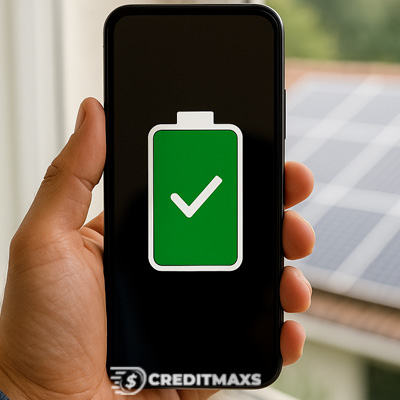See How to Charge Your Cell Phone with Sunlight: Discover the New Technology That Is Being Developed
Charge your cell phone with sunlight, a phrase that once seemed like science fiction is now becoming a tangible reality.
Today let’s explore the cutting-edge developments that allow you to charge your cell phone with sunlight, the science behind them, and what this means for the future of portable electronics.
Charge Your Cell Phone with Sunlight: A New Frontier in Mobile Technology ☀️
With the rising global emphasis on sustainability and renewable energy, tech companies are exploring innovative solutions that reduce dependence on traditional charging methods.
One standout development showcased at the Mobile World Congress (MWC) 2025 was Infinix’s prototype of a smartphone and smart case powered by solar energy.
This breakthrough represents a critical step toward environmentally conscious mobile devices, aiming to provide users with greater autonomy and convenience, especially in situations where power outlets are unavailable.
But how exactly does this technology work? What kind of efficiency can we expect? And will this become the new normal in the smartphone market?
Understanding the Technology to Charge Your Cell Phone with Sunlight 🔋
The central idea behind charging a cell phone with sunlight lies in converting solar energy into usable electrical power through photovoltaic cells.
In the case of Infinix’s recent prototypes, the company introduced a solar charging system based on perovskite solar cells, a material considered more efficient than traditional silicon in low-light conditions.
These solar cells are embedded either into the back panel of the phone or into a specialized smart case that connects to the phone via side-mounted contact points.

The system generates up to 2 watts of power, enough to recover around 10% of battery per hour under optimal sunlight exposure.
What sets this technology apart is its ability to work even in indirect lighting, such as cloudy days or indoor environments with ambient light.
Additionally, Infinix included AI-based functionality named “Sunflower Mode”, which mimics the way real sunflowers turn toward light sources.
This software feature adjusts the phone’s position (or provides users with guidance) to maximize light absorption.
Why Charge Your Cell Phone with Sunlight Matters for the Future? 📱
- Energy access in remote areas: For users in rural or underdeveloped regions with limited access to electricity, solar-powered phones offer a practical solution.
- Sustainability: As the electronics industry faces pressure to reduce carbon footprints, integrating renewable energy aligns with environmental goals.
- Emergency situations: Whether during natural disasters, power outages, or travel, solar charging provides an alternative way to stay connected.
- Extended mobility: Frequent travelers, campers, and digital nomads benefit from backup charging sources on the go.
While solar charging may not completely replace traditional charging methods yet, it offers significant support in situations where plug-in power isn’t an option.
Challenges of Trying to Charge Your Cell Phone with Sunlight 🔎
Despite the exciting potential, there are still important limitations to consider:
- Charging speed: At 2W output, solar charging is still much slower than conventional wall chargers or even USB power banks. It’s best viewed as supplemental rather than primary charging.
- Surface area limitations: Smartphones have limited space to house efficient solar panels without compromising design. The introduction of solar-charging cases helps address this but adds bulk.
- Weather dependency: While perovskite cells perform well under varied lighting, extended cloudy periods or heavy indoor use can hinder performance.
- Durability and cost: Perovskite technology, though promising, is still under development and may face hurdles related to lifespan and production costs.
Innovative Designs That Help You Charge Your Cell Phone with Sunlight 🎯
The Infinix prototype isn’t the only device exploring solar-powered solutions. A growing number of concepts and products have emerged, including:
- Wearable solar bands: Integrated solar strips that connect via USB or magnetically attach to phones.
- Foldable solar mats: Compact, roll-out mats you can carry in a backpack, designed to power not only phones but also laptops and small appliances.
- Smartphone cases with flexible panels: Accessories that allow for solar charging without interfering with phone usage or aesthetics.
The Rise of Solar-Powered Smartphones 📍
While still in its early stages, Infinix’s innovation signals a broader industry trend toward sustainability and energy independence.
Though the power output is modest for now, ongoing research into perovskite cells, AI-assisted energy management, and smart accessory design continues to evolve.
For those who spend time outdoors, travel frequently, or seek greener habits, solar charging could soon be a game-changer.
As technology progresses, the dream of a fully self-charging phone, powered by the sun, might be closer than we think.
Frequently Asked Questions ❓
1. Do I need direct sunlight for solar charging to work?
- No. Thanks to perovskite solar cells, the device can generate energy even under indirect lighting, including cloudy weather or indoor light. However, direct sunlight is still the most effective source.
3. Are solar charging phones already available in the market?
- Not yet. Infinix’s technology is still in the prototype phase, and no official commercial launch date has been announced. Other solar accessories are available, but full integration into smartphones is still being refined.
3. Can I use solar charging while using my phone?
- Yes, though the effectiveness will depend on how much sunlight the panel is exposed to and your phone’s current power consumption.